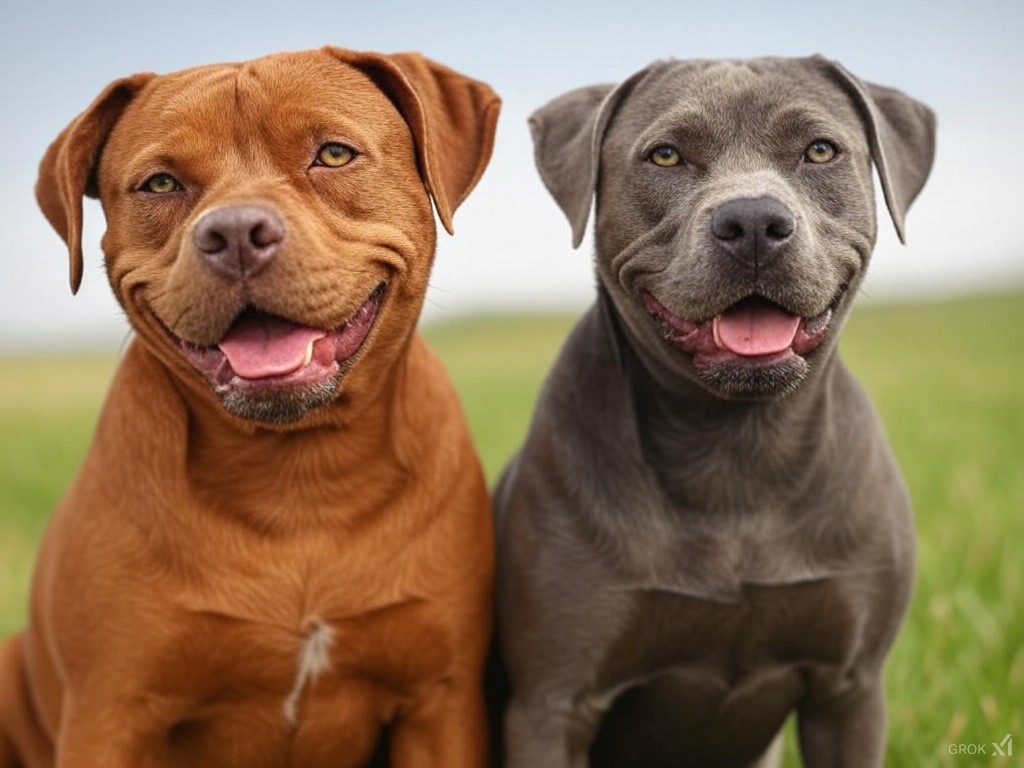Pitbulls are known for their strength, loyalty, and affectionate nature. Among the most recognizable types of Pitbulls are the Red Nose and Blue Nose varieties. Although they share many similarities, these two types have unique characteristics that set them apart.
This guide will help you understand the differences between Red Nose and Blue Nose Pitbulls and provide valuable insights for choosing the right one for you.
History and Origins
Pitbulls, including Red Nose and Blue Nose types, trace their roots to the 19th century in England. They were initially bred as working dogs, known for their courage and determination (American Kennel Club – Pitbull History).
Over time, selective breeding led to the development of different lines, including the Red Nose and Blue Nose varieties. Red Nose Pitbulls are believed to have originated from the Old Family Red Nose line, renowned for their unique reddish coloring. Blue Nose Pitbulls, on the other hand, are a result of breeding practices focused on producing the distinctive bluish-gray pigmentation.
Physical Differences
Coat Color and Appearance
Red Nose Pitbulls have a warm reddish-brown coat, often accompanied by a matching nose and amber or light-colored eyes (United Kennel Club – American Pit Bull Terrier). Blue Nose Pitbulls, in contrast, exhibit a bluish-gray coat, paired with a slate-colored nose and piercing blue or gray eyes.
Nose and Eye Pigmentation
The Red Nose variety has a copper-toned nose that gives it its name, while the Blue Nose Pitbull’s nose has a more muted blue-gray shade. These pigmentation traits are what make them easily distinguishable.
Size and Build Comparisons
Both types are muscular and athletic, but their size and build can vary slightly. Red Nose Pitbulls are often leaner, while Blue Nose Pitbulls may appear stockier due to selective breeding.
Temperament and Personality
General Temperament
Both Red Nose and Blue Nose Pitbulls are known for their loving, loyal, and playful nature (ASPCA – Pitbull Temperament). They thrive on human interaction and are often called “nanny dogs” because of their protective instincts around children.
Red Nose Pitbull Personality
Red Nose Pitbulls tend to exhibit a more outgoing and energetic personality. They are eager to please and often form strong bonds with their families.

Blue Nose Pitbull Personality
Blue Nose Pitbulls are typically calmer and more reserved. They are affectionate and love spending quiet moments with their owners, making them ideal for families seeking a more laid-back companion.
Health and Lifespan
Common Health Issues
Red Nose Pitbulls can face skin allergies and hip dysplasia, while Blue Nose Pitbulls are more prone to issues like heart disease and immune deficiencies due to inbreeding (PetMD – Common Pitbull Health Issues).
Life Expectancy
Both types generally live between 12 to 15 years, provided they receive proper care, regular vet checkups, and a healthy diet.
Training and Socialization
Pitbulls are intelligent and eager to learn, making training relatively straightforward when approached with consistency and patience (Dogtime – Pitbull Training Tips).
Tips for Red Nose Pitbulls
Due to their high energy levels, Red Nose Pitbulls benefit from structured activities like agility training and long walks. Early socialization is essential to curb excessive excitement.
Tips for Blue Nose Pitbulls
Blue Nose Pitbulls, being more relaxed, excel in obedience training and are less likely to exhibit hyperactivity. Socialization helps them adapt to different environments and people.
Popularity and Cost
Red Nose Pitbulls are often sought after for their striking appearance and fiery personalities, while Blue Nose Pitbulls are prized for their unique coloration and calm demeanor. On average, Blue Nose Pitbulls tend to be more expensive due to the rarity of their pigmentation (Pitbull Rescue Central – Blue Nose Pitbulls).
Prices for either type can range from $500 to $3000, depending on pedigree and breeder reputation.
Family and Lifestyle Compatibility
Red Nose Pitbulls are perfect for active families or individuals who can keep up with their energy levels. They love outdoor adventures and playtime.
Blue Nose Pitbulls, with their calmer disposition, are ideal for families seeking a more relaxed pet. They adapt well to quieter households and are content with moderate exercise.
Care Tips for Red and Blue Nose Pitbulls
- Exercise: Both types need daily physical activity to stay healthy and happy.
- Diet: A balanced diet rich in protein ensures their muscles and energy levels are maintained.
- Grooming: Regular brushing keeps their short coats shiny and reduces shedding.
- Mental Stimulation: Toys, puzzles, and training sessions keep them mentally engaged.
Ethical Breeding and Adoption
Responsible breeding is crucial for both Red Nose and Blue Nose Pitbulls to avoid health issues. Adopting from reputable breeders or rescues ensures you get a healthy dog. Adopting from reputable breeders or rescues ensures you get a healthy dog (Your Purebred Puppy – Guide to Ethical Dog Breeding).
Common Myths and Misconceptions
Many people mistakenly believe that Red Nose and Blue Nose Pitbulls are aggressive or dangerous. In reality, their temperament depends on training and environment. With proper care and love, they make loyal and affectionate companions.
Red Nose vs. Blue Nose: Which Is Right for You?
Choosing between a Red Nose and Blue Nose Pitbull depends on your lifestyle and preferences. If you’re active and love outdoor activities, a Red Nose may be the better fit. If you prefer a more relaxed companion, a Blue Nose could be ideal.
Conclusion
Both Red Nose and Blue Nose Pitbulls are incredible breeds, each with unique qualities that make them stand out. By understanding their differences in appearance, temperament, and care needs, you can make an informed decision on the best companion for your home. Whether it’s the fiery charm of a Red Nose or the calm elegance of a Blue Nose, both types bring endless joy and loyalty to their families.









